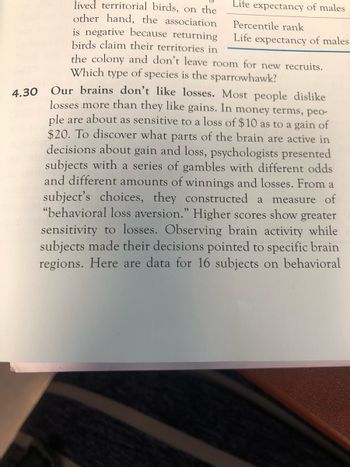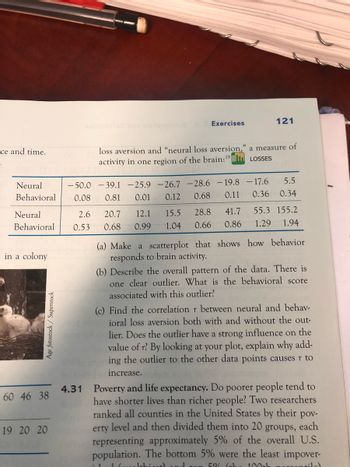
MATLAB: An Introduction with Applications
6th Edition
ISBN: 9781119256830
Author: Amos Gilat
Publisher: John Wiley & Sons Inc
expand_more
expand_more
format_list_bulleted
Question
Can you please help with 4.30 sulfur, the ocean and the sun? Only part A which is make a scatter plot that shows how DMS responds to SRD.

Transcribed Image Text:4.30
lived territorial birds, on the
other hand, the association
is negative because returning
birds claim their territories in
the colony and don't leave room for new recruits.
Which type of species is the sparrowhawk?
Life expectancy of males
Percentile rank
Life expectancy of males
Our brains don't like losses. Most people dislike
losses more than they like gains. In money terms, peo-
ple are about as sensitive to a loss of $10 as to a gain of
$20. To discover what parts of the brain are active in
decisions about gain and loss, psychologists presented
subjects with a series of gambles with different odds
and different amounts of winnings and losses. From a
subject's choices, they constructed a measure of
"behavioral loss aversion." Higher scores show greater
sensitivity to losses. Observing brain activity while
subjects made their decisions pointed to specific brain
regions. Here are data for 16 subjects on behavioral

Transcribed Image Text:ce and time.
Neural
Behavioral
Neural
Behavioral
= in a colony
Age fotostock/Superstock
60 46 38
19 20 20
2.6
0.53
-50.0 -39.1 -25.9 -26.7 -28.6 -19.8
0.01 0.12 0.68
0.08
0.81
0.11
4.31
loss aversion and "neural loss aversion," a measure of
activity in one region of the brain: 19
LOSSES
20.7
0.68
Exercises
12.1 15.5
0.99
1.04
28.8
0.66
41.7
0.86
121
5.5
0.36 0.34
-17.6
55.3 155.2
1.29
1.94
(a) Make a scatterplot that shows how behavior
responds to brain activity.
(b) Describe the overall pattern of the data. There is
one clear outlier. What is the behavioral score
associated with this outlier?
(c) Find the correlation r between neural and behav-
ioral loss aversion both with and without the out-
lier. Does the outlier have a strong influence on the
value of r? By looking at your plot, explain why add-
ing the outlier to the other data points causes r to
increase.
Poverty and life expectancy. Do poorer people tend to
have shorter lives than richer people? Two researchers
ranked all counties in the United States by their pov-
level and then divided them into 20
erty
each
groups,
representing approximately 5% of the overall U.S.
population. The bottom 5% were the least impover-
1 (alchigar) and top 5% (the 100tk
montile)
Expert Solution
This question has been solved!
Explore an expertly crafted, step-by-step solution for a thorough understanding of key concepts.
Step by stepSolved in 2 steps with 1 images

Knowledge Booster
Similar questions
- Please please PLEASE HELP ME!!!! i have literally been stuck on this same question for 3 days. I am stressed and I just need someone who knows how to solve this step by step. I would be sooooooo grateful to you!arrow_forwardCan you please analyse this for me. Step by step please.arrow_forwardCan you please analyse this for me. Step by step please.arrow_forward
- An outbreak of the deadly Ebola virus in 2002 and 2003 killed 91 of the 95 gorillas in 7 home ranges in the Congo. To study the spread of the virus, measure ' distance' by the number of home ranges separating a group of gorillas from the first group infected. Here are data on distance and number of days until deaths began in each later group: Distance x 12 6747 317 32 39 45 50 Days y We know that Ex = 27, Ey = 186, Exy = 1032, Ex? = 155 and Ey = 7368 for this sample. (a) Find the equation of the least squares regression line. (b) Find the linear correlation coefficient r between x and y, correct to four decimal places.arrow_forwardA patient is classified as having gestational diabetes if their average glucose level is above 140 milligrams per deciliter (mg/dl) one hour after a sugary drink is ingested. Rebecca's doctor is concerned that she may suffer from gestational diabetes. There is variation both in the actual glucose level and in the blood test that measures the level. Rebecca's measured glucose level one hour after ingesting the sugary drink varies according to the Normal distribution with μ=140+5 mg/dl and σ=5+1 mg/dl. Using the Central Limit Theorem, determine the probability of Rebecca being diagnosed with gestational diabetes if her glucose level is measured: Once? n=5+2 times n=5+4 times Comment on the relationship between the probabilities observed in (a), (b), and (c). Explain, using concepts from lecture why this occurs and what it means in context.arrow_forwardA medical trial is conducted to test whether or not a certain drug can treat acertain allergy. Upon trial, the t-value is computed as 1.311. Sketch andcomplete the table below to discuss the findings of the medical trial.arrow_forward
arrow_back_ios
SEE MORE QUESTIONS
arrow_forward_ios
Recommended textbooks for you
 MATLAB: An Introduction with ApplicationsStatisticsISBN:9781119256830Author:Amos GilatPublisher:John Wiley & Sons Inc
MATLAB: An Introduction with ApplicationsStatisticsISBN:9781119256830Author:Amos GilatPublisher:John Wiley & Sons Inc Probability and Statistics for Engineering and th...StatisticsISBN:9781305251809Author:Jay L. DevorePublisher:Cengage Learning
Probability and Statistics for Engineering and th...StatisticsISBN:9781305251809Author:Jay L. DevorePublisher:Cengage Learning Statistics for The Behavioral Sciences (MindTap C...StatisticsISBN:9781305504912Author:Frederick J Gravetter, Larry B. WallnauPublisher:Cengage Learning
Statistics for The Behavioral Sciences (MindTap C...StatisticsISBN:9781305504912Author:Frederick J Gravetter, Larry B. WallnauPublisher:Cengage Learning Elementary Statistics: Picturing the World (7th E...StatisticsISBN:9780134683416Author:Ron Larson, Betsy FarberPublisher:PEARSON
Elementary Statistics: Picturing the World (7th E...StatisticsISBN:9780134683416Author:Ron Larson, Betsy FarberPublisher:PEARSON The Basic Practice of StatisticsStatisticsISBN:9781319042578Author:David S. Moore, William I. Notz, Michael A. FlignerPublisher:W. H. Freeman
The Basic Practice of StatisticsStatisticsISBN:9781319042578Author:David S. Moore, William I. Notz, Michael A. FlignerPublisher:W. H. Freeman Introduction to the Practice of StatisticsStatisticsISBN:9781319013387Author:David S. Moore, George P. McCabe, Bruce A. CraigPublisher:W. H. Freeman
Introduction to the Practice of StatisticsStatisticsISBN:9781319013387Author:David S. Moore, George P. McCabe, Bruce A. CraigPublisher:W. H. Freeman

MATLAB: An Introduction with Applications
Statistics
ISBN:9781119256830
Author:Amos Gilat
Publisher:John Wiley & Sons Inc

Probability and Statistics for Engineering and th...
Statistics
ISBN:9781305251809
Author:Jay L. Devore
Publisher:Cengage Learning

Statistics for The Behavioral Sciences (MindTap C...
Statistics
ISBN:9781305504912
Author:Frederick J Gravetter, Larry B. Wallnau
Publisher:Cengage Learning

Elementary Statistics: Picturing the World (7th E...
Statistics
ISBN:9780134683416
Author:Ron Larson, Betsy Farber
Publisher:PEARSON

The Basic Practice of Statistics
Statistics
ISBN:9781319042578
Author:David S. Moore, William I. Notz, Michael A. Fligner
Publisher:W. H. Freeman

Introduction to the Practice of Statistics
Statistics
ISBN:9781319013387
Author:David S. Moore, George P. McCabe, Bruce A. Craig
Publisher:W. H. Freeman